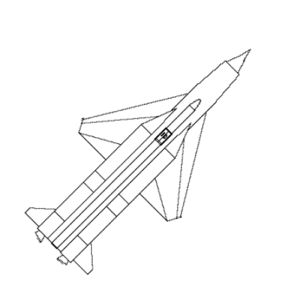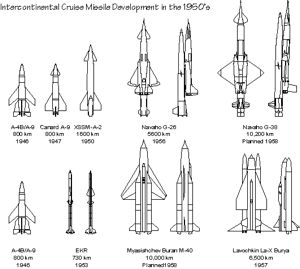
Home - Search - Browse - Alphabetic Index: 0- 1- 2- 3- 4- 5- 6- 7- 8- 9
A- B- C- D- E- F- G- H- I- J- K- L- M- N- O- P- Q- R- S- T- U- V- W- X- Y- Z
Buran M-40
 Buran missile Credit: © Mark Wade |
AKA: Buran;M-40. Status: Cancelled 1957. Thrust: 2,156.00 kN (484,688 lbf). Gross mass: 125,000 kg (275,000 lb). Height: 28.00 m (91.00 ft). Diameter: 2.40 m (7.80 ft).
A final government decree on 20 May 1954 authorized the Lavochkin and Myasishchev aircraft design bureaus to proceed in parallel with full-scale development of trisonic intercontinental cruise missiles. Both missiles would use ramjet engines by Bondaryuk, astronavigation systems by R Chachikyan, inertial navigation systems by G Tolstoysov, and aerodynamics developed by TsAGI (Central Hydrodynamics Institute). Myasishchev's Buran would use rocket booster engines built by Glushko. While both missiles were to deliver a nuclear warhead over an 8,500 km range, the warhead design specified for the Myasishchev missile had a total mass of 3,500 kg, two thirds heavier than that specified for the Lavochkin.
The TsAGI configuration for the cruise stage was of conventional layout, with a thin profile 70 degree swept arrow wing mounted at mid-fuselage. The fuselage itself was cylindrical and area-ruled, with the classic ramjet shock cone in a nose intake. The astronavigation and guidance systems were mounted in a dorsal fairing. The star scanners of the system looked out through quartz windows.
Myasishchev had began work in April 1953, before the official authorization, on his RSS-40 (RSS= rocket-aircraft system), code-named Buran (snowstorm). The RSS-40 would consist of two stages, a four-rocket boost stage (the M-41) and a ramjet cruise stage (the M-42). The RSS-40 would be launched vertically from an ingenious transporter-launcher, designed by V K Karrask. The RSS-40 was 24 m long, had an 11.6 m wingspan, a total mass of 125 metric tons, and cruised at 3000 to 3200 km/hr. The ramjet intake cone was canted 3 degrees downward, which represented the pitch angle of the missile in cruise.
Several variants of the Myasishchev M-42 cruise stage were studied. Some were related to improving the missile guidance, including an auxiliary communications package for providing en-route navigation and targeting updates, as was planned for the competing Burya. Another laid out a piloted version, with a cockpit installed in the cruise stage. The pilot would eject and be recovered by parachute at the conclusion of the mission. Myasishchev planned several manned flights to explore the psychology of human flight on the edge of space.
By 1956 Myasishchev was just completing project design, while Lavochkin was already completing construction of the first missile. Burya was launched first, in July 1957, but exploded in its first launch. But events now conspired against the project. The US Navaho was cancelled ten days later. Korolev's R-7 ICBM completed its first successful test flight in August, at the same time the first two Buran missiles were completed at the factory. Buran was being prepared for its first flight when Myasishchev's project was cancelled on November 1957. The Soviet leadership did not see any need for continued development of a parallel ramjet design.
Stage Data - Buran
- Stage 1. 4 x Buran M-41. Gross Mass: 18,000 kg (39,000 lb). Empty Mass: 3,000 kg (6,600 lb). Thrust (vac): 755.000 kN (169,730 lbf). Isp: 254 sec. Burn time: 50 sec. Isp(sl): 231 sec. Diameter: 1.20 m (3.90 ft). Span: 3.00 m (9.80 ft). Length: 19.10 m (62.60 ft). Propellants: Nitric acid/Kerosene. No Engines: 1. Engine: RD-213. Status: Development 1957 November. Comments: Booster for Buran missile. Four used to boost ramjet second stage to ignition conditions. Masses estimated based on missile known total mass. Specific impulse estimated.
- Stage 2. 1 x Buran M-42. Gross Mass: 53,000 kg (116,000 lb). Empty Mass: 15,000 kg (33,000 lb). Thrust (vac): 103.900 kN (23,358 lbf). Isp: 1,500 sec. Burn time: 8,500 sec. Diameter: 2.40 m (7.80 ft). Span: 11.60 m (38.00 ft). Length: 23.30 m (76.40 ft). Propellants: Air/Kerosene. No Engines: 1. Engine: RD-020. Status: Development 1957 November. Comments: Boosted by 4 x Glushko-engined boosters. 8,500 km cruise at Mach 3.1 at 18-20 km altitude with 3,500 kg warhead. Wing area 98 square meters; diameter of ramjet 2.0 m. Never reached flight test. Masses estimated based on missile known total mass.
| Buran M Russian intercontinental cruise missile. A government decree on 20 May 1954 authorized the Myasishchev aircraft design bureau to proceed with full-scale development of the Buran trisonic intercontinental cruise missile. The competing Burya design of Lavochkin was launched in July 1957, but the development of unstoppable ICBM's had made intercontinental cruise missiles obsolete. The equivalent American Navaho project was cancelled ten days later. Korolev's R-7 ICBM completed its first successful test flight in August. Buran was being prepared for its first flight when Myasishchev's project was cancelled on November 1957. In an attempt to continue the project, two manned variants were proposed as follow-on projects, to no avail. |
| Buran RSS-52 Russian air-launched test vehicle. Hypersonic ramjet-powered research vehicle proposed by Myasishchev in 1958. This version of the cancelled Buran intercontinental cruise missile would have been air-launched at supersonic speed from a derivative of the M-50 bomber. It would then use its own ramjet to accelerate to hypersonic velocity. |
| Buran M-42 Russian intercontinental cruise missile. Cancelled 1957. Several variants of the Myasishchev Buran trisonic intercontinental cruise missile M-42 cruise stage were studied, including a piloted version. |
| Buran M-44 Russian manned ramjet-powered research aircraft. Study 1958. Air-launched derivative of the Buran Mach 3 high altitude cruise missile system, proposed for use as an unmanned high speed research vehicle. |
Country: Russia.
 | Buran Missile 2 view Credit: © Mark Wade |
 | Navaho vs Burya Credit: © Mark Wade |
1957 November - . LV Family: Buran M. Launch Vehicle: Buran M-40.
- Buran trisonic intercontinental cruise missile cancelled. - .
Nation: Russia.
Related Persons: Lavochkin,
Myasishchev.
Program: Navaho.
Spacecraft Bus: Buran M.
Spacecraft: Buran M-42.
Council of Soviet Ministers (SM) Decree 'On termination of work on the 40 Buran intercontinental cruise missile' was issued. Buran was being prepared for its first flight when Myasishchev's project was cancelled. After successful flight tests of Lavochkin's Burya missile, the Soviet leadership did not see any need for continued development of a parallel ramjet design. Following the cancellation, Myasishchev sought approval for test of an air-launched version.
Back to top of page
Home - Search - Browse - Alphabetic Index: 0- 1- 2- 3- 4- 5- 6- 7- 8- 9
A- B- C- D- E- F- G- H- I- J- K- L- M- N- O- P- Q- R- S- T- U- V- W- X- Y- Z
© 1997-2019 Mark Wade - Contact
© / Conditions for Use